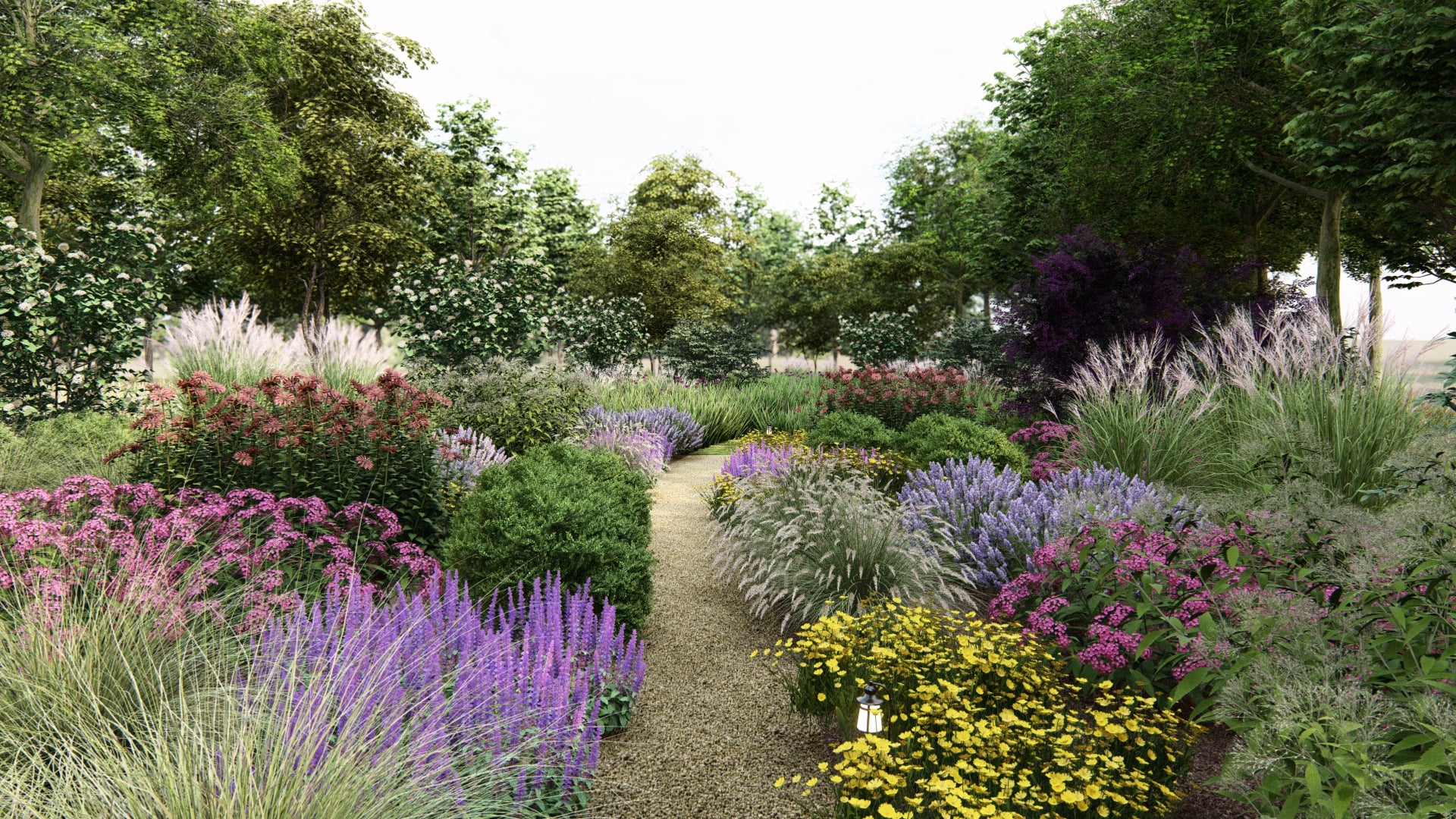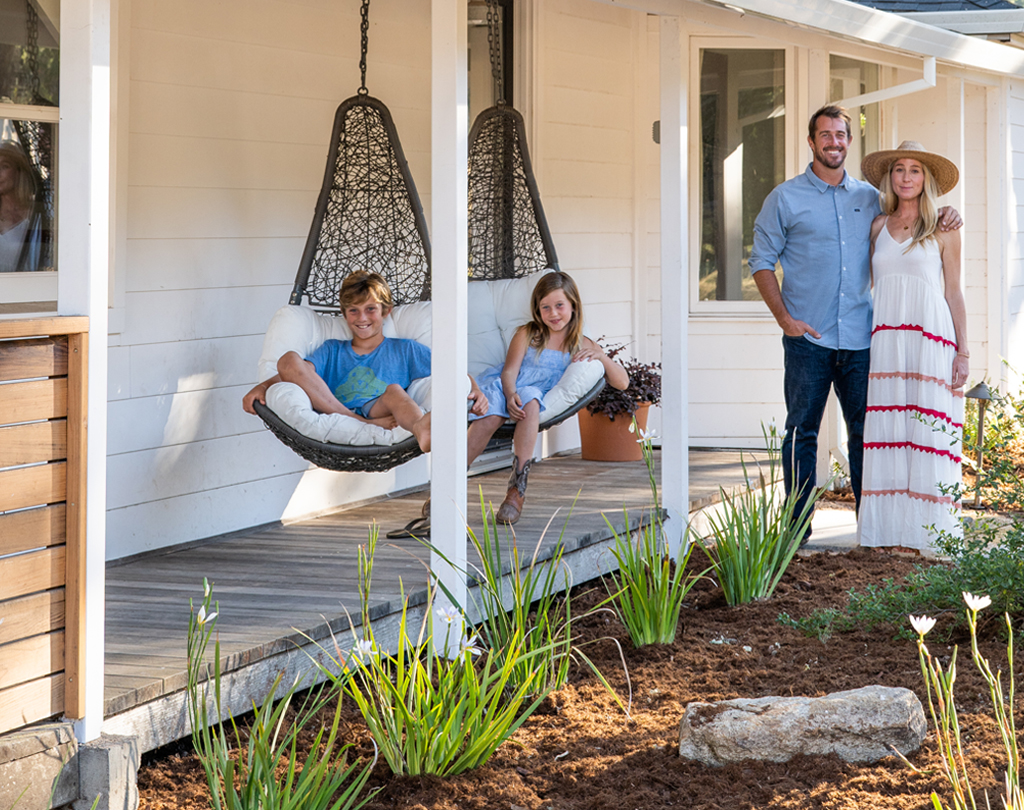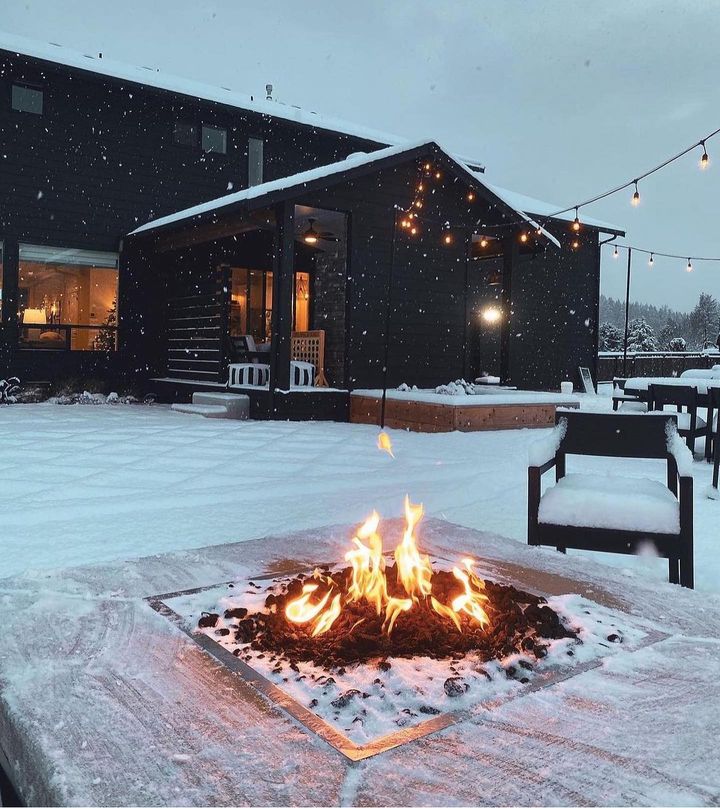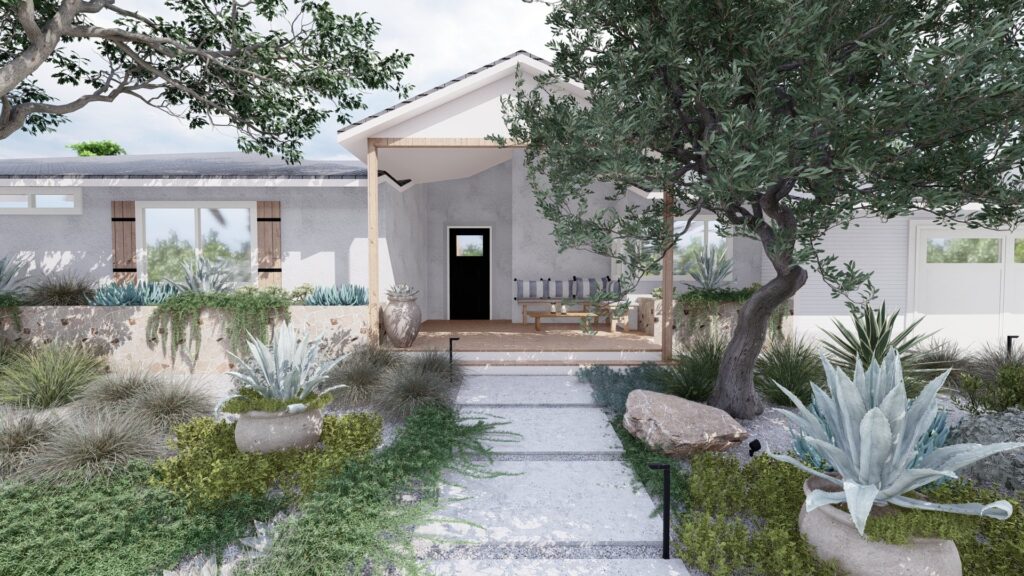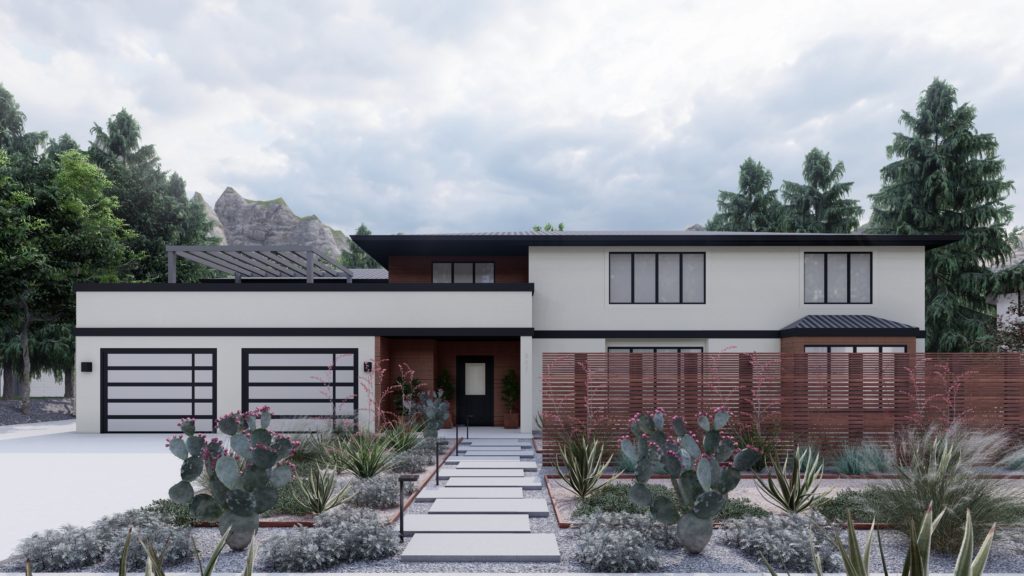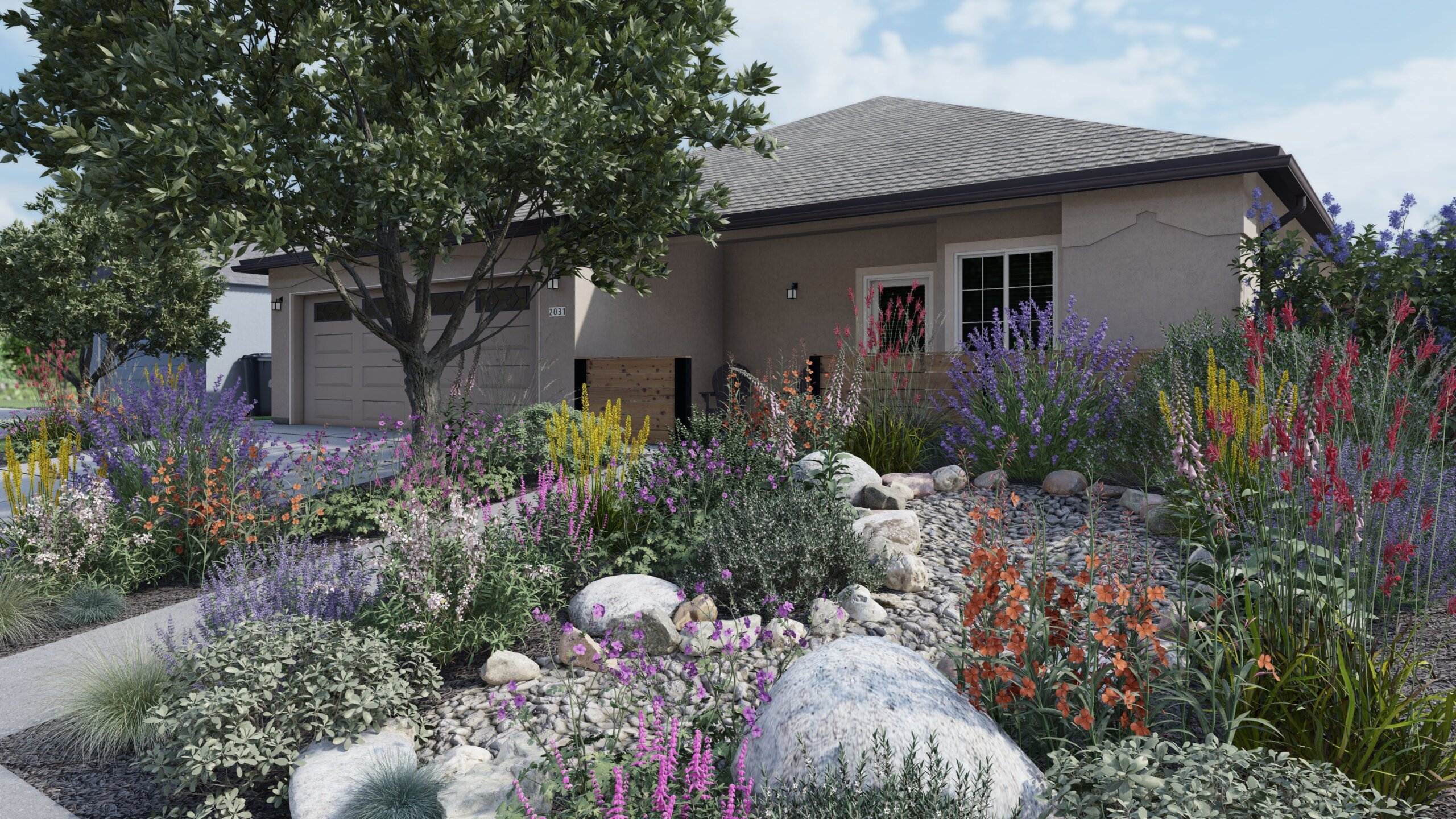
Ready to design your dream yard?
Get StartedFor those of us who call American residential neighborhoods our sanctuary, the idea of rewilding might seem like a radical departure from the neat and tidy landscapes we’re accustomed to. Yet, as concerns about the environment and our impact on it grow, more homeowners are discovering the beauty and benefits of sustainable landscaping, and most importantly, embracing wildness in their own outdoor spaces. Whether you have a sprawling backyard or a small front yard, rewilding offers a harmonious solution that not only supports biodiversity but also enhances the visual appeal and enjoyment of your surroundings.
Here we’ll delve into the core principles of rewilding and its profound environmental benefits, discuss small and simple ways this movement can foster a thriving ecosystem right in your own backyard, and share some of our favorite rewilded yards designed by the team of remote landscape designers at Yardzen.

What is Rewilding and Why is it Important?
Rewilding is a transformative approach to land management that seeks to restore natural ecosystems and processes by allowing nature to reclaim spaces that were once human-altered. It’s about creating a harmonious balance between humans and the environment, where native plants, animals, and natural processes can flourish.
At its core, rewilding is a celebration of biodiversity and the intricate web of life that sustains our planet. By reintroducing native plants, which are adapted to the local climate and soil conditions, you’re not only creating a beautiful landscape but also providing essential habitat and food sources for native insects, birds, and other wildlife. This not only supports local ecosystems but also contributes to the overall health of the planet.


How to Rewild Your Yard
Rewilding is vital for several reasons:
- Biodiversity Conservation: The loss of biodiversity is a global concern, with many species facing extinction due to habitat loss and degradation. By rewilding your yard, you play a crucial role in preserving and enhancing local biodiversity, which in turn contributes to the resilience of ecosystems.
- Pollinator Support: Pollinators like bees, butterflies, and birds, are essential for the reproduction of many plants, including those we rely on for food. Entomologist and author Dr. Doug Tallamy’s work has shown that pollinators are necessary to grow one-third of our crops and if they were to disappear, nearly 90 percent of plants on Earth would also disappear. Rewilded yards create suitable habitats to attract and support these vital pollinators.
- Carbon Sequestration: Natural ecosystems are efficient at capturing and storing carbon dioxide, helping to mitigate climate change. Rewilding can aid in carbon sequestration, contributing to a healthier environment.
- Water Management: Native plants used in rewilded areas are well-adapted to local rainfall patterns and soil types, reducing the need for irrigation. They also improve water quality by increasing onsite capture of pollutant-laden runoff.
- Ecosystem Services: Rewilded areas provide ecosystem services such as air and water purification, flood control, and erosion prevention, benefiting both local communities and the broader environment.
- Educational Opportunities: Rewilding your yard can serve as a learning tool for yourself, your family, and your community. It’s an opportunity to connect with the natural world, learn about local ecology, and inspire others to take similar steps.
- Resilience to Climate Change: Diverse ecosystems are more resilient in the face of environmental changes, including climate-related shifts. Rewilded yards can serve as microcosms of adaptability in the changing world.
By rewilding your yard, you contribute to a larger movement that seeks to restore the health of our planet, one yard at a time. It’s a tangible way to make a positive impact, no matter the size of your space (even small pockets of rewilded landscapes can offer meaningful value to your local ecosystem). As you embark on this journey, you’ll not only witness the transformation of your surroundings but also cultivate a profound sense of connection to the natural world and a renewed commitment to preserving its beauty and vitality.
Include Native Plants
You can support biodiversity and healthy ecosystems by using native, habitat-supporting plants in your yard. If you’re not sure which plant varieties are native to your area, consult your local nursery or visit Audobon.org or the National Wildlife Foundation’s Native Plant Finder and enter your zip code for a list of plants native to where you live. Ideally, you’ll want plants that are native to your specific area – not just your state – as the latter can vary drastically in terms of climates and landscape regions. When you can, opt for pure natives that support multiple species of fauna, rather than cultivars of native species (“nativars”) which tend to have far less ecological value. Native plants have the added benefit of being low-maintenance once established, requiring few to no inputs of water and fertilizer.
Ideally, the majority of plants in your yard are native in order to produce a true rewilded space. That being said, if you’re after a certain look or want your garden to fit in within your neighborhood, it’s acceptable to pepper in a few non-native species, especially climate-adapted plants that grow well in your region and are known to support generalist fauna species.

Plant Densely and Diversely
Wild plant communities feature dense, layered vegetation. To maximize the ecological value of your rewilded yard, include multiple layers of plants, and position them close to each other. Begin with groundcover plants (that’s where a lot of the magic happens) and work your way up in increments (low shrubs, medium-height wildflowers, towering ornamental grasses) until you hit the tree tops (where there’s also a good deal of magic happening).
The more native plant species you include, the more valuable your garden will be for the local ecosystem. The majority of insect species are “specialists”, requiring a specific plant for habitat. By planting a diverse array of native plant species, you increase the odds that those specialists will have a seat at the table in your garden.
Use Your Soil, Don’t Add Much to It
The standard suburban garden imports nutrient-packed garden soil to create an artificial environment that allows non-native nursery plants to live in places they would not naturally exist in. Keep it real: use the soil you’ve got, and take the time to select native species that actually belong in your specific area and site conditions. Some plants actually suffer from garden soil’s richness, and do better in the depleted soils of their native range. As they say: right plant, right place.
Pesticides and chemical fertilizers can harm as much as they may help. Feel free to add compost to your garden, but avoid any chemical additives. It may surprise you, but excess nutrients from fertilizers, even organic ones, can lead to pollution downstream.
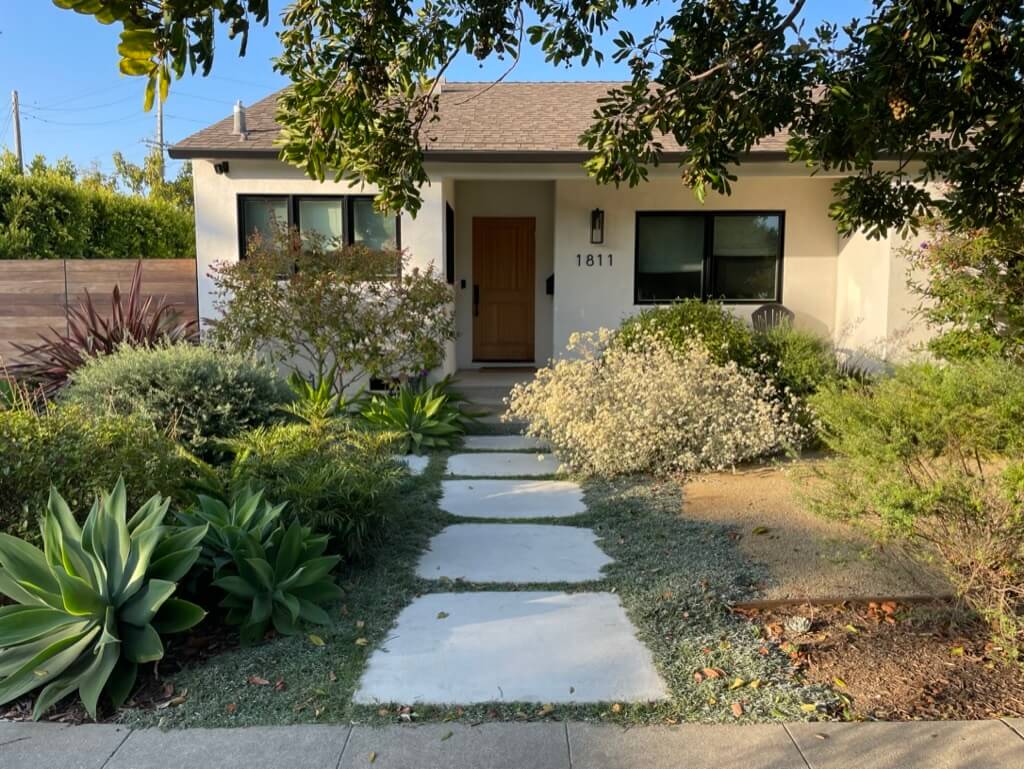
Provide Additional Habitat
Beyond planting natives that create foraging opportunities, you can also add natural water features and wildlife-friendly elements that encourage the presence of animals and insects and create opportunities for habitat. Including water features like ponds, birdbaths or planting rain gardens can support various species, providing drinking and bathing spots for important pollinators and migratory animals.
Adding natural elements like fallen logs and rocks, or shelters like birdhouses and feeders for shelter and nesting, and incorporating practices like leaving dead plant matter around to provide additional hiding places for wildlife, can also support and sustain wildlife in your rewilded space.

Capture Rainwater
To maximize the amount of water that soaks into the ground, you’ll want to plant as many native plants and trees as your space allows, and limit the amount of impermeable (paved) surfaces, which can cause the water to be lost to runoff. Plants, and trees especially, increase water infiltration rates by breaking up the soil with their roots. They’re also incredibly proficient at slowing down rainwater, allowing ample time for it to be absorbed. Trees’ canopies catch rain, holding it captive before it drips to the ground, and plants’ foliage acts as a natural barrier that blocks water – both slowing water down enough that it can be absorbed efficiently before it flows into a city drain.
While some paving may be necessary for elements like driveways and patios, you may opt for alternatives like gravel or planting groundcover between pavers, creating more permeable surfaces that allow water to be absorbed. Additionally, rain barrels are another way to capture runoff water and reuse it for irrigation. When not collected, rain water becomes water runoff that collects pesticides, chemicals, and other materials. By reducing water runoff, we also reduce the waste that finds its way into our waterways.
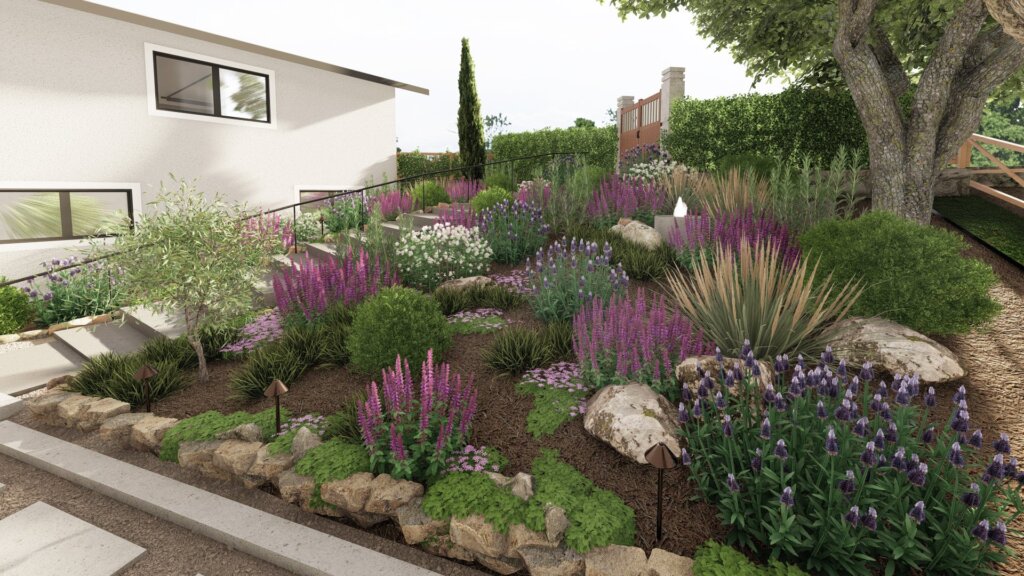
Reduce Heat Islands
Heat islands are urbanized areas that experience higher temperatures due to the presence of concrete and other hard, constructed infrastructure, which absorbs and re-emits the sun’s heat while stifling the cooling effect of airflow. Fortunately, it’s easy to combat the cycle in your own yard. Replacing paved surfaces with native planting designs will lower ground level temperatures. Expanding native tree canopy will cast shade over hardscape surfaces and structures, keeping temperatures cool. No room for a tree? Pergolas and other shade structures can also help combat excessive heat.
Our Favorite Rewilded Yard Designs
Here we’ve gathered our favorite landscape designs completed for real Yardzen clients that include rewilding techniques.
Looking for other no-lawn design ideas? Have a look at some of our favorite no-grass front yards and more sustainable landscaping tips.

This pollinator paradise in Davis, California transforms what was previously a grass turf lawn into a drought-tolerant yard full of colorful blooms to attract bees and hummingbirds and a dry river bed, designed to be a permeable surface in the sloped yard.
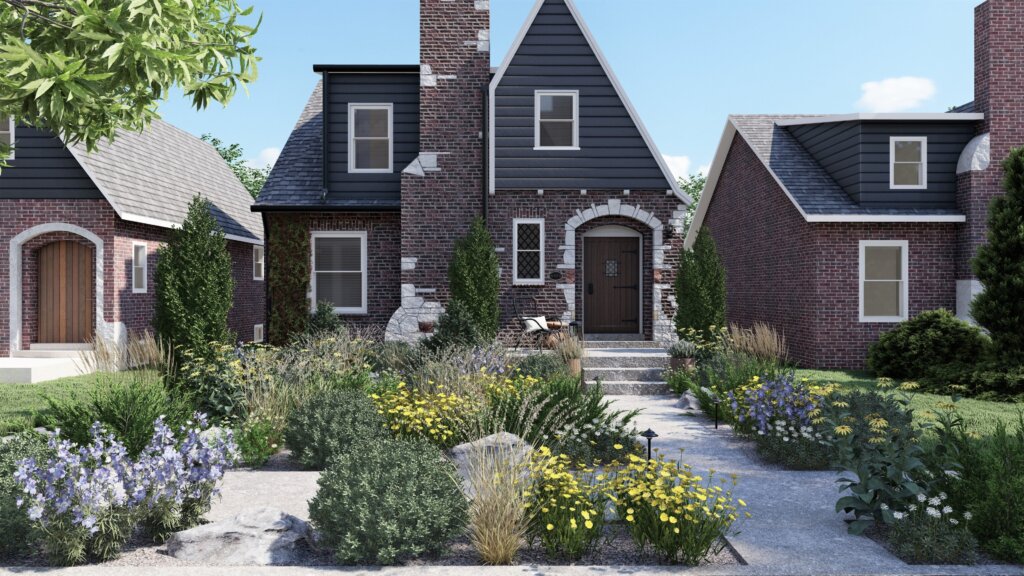
This landscape design for a home in St. Louis, MO incorporates organic cottage style and rewilding principles into the front yard and the curb strip, allowing passerby to fully appreciate this perfectly, imperfect style. The soft palette of native wildflowers and grasses is complimented by the occasional structural evergreen and statement boulder.
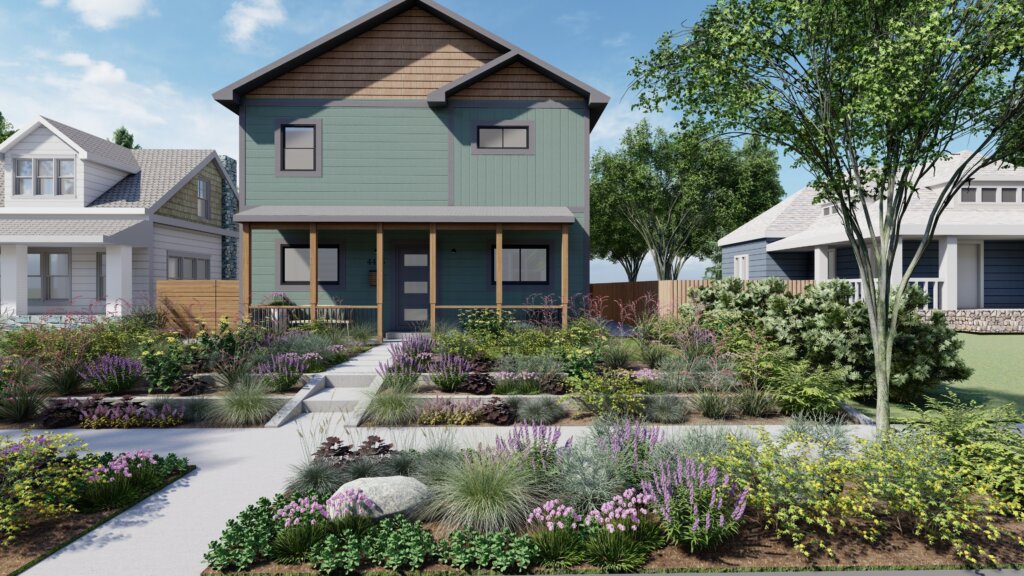
This Denver home includes a layered botanical design centered on xeriscaping. The drought-tolerant plants (like Hesperaloe parviflora and Andropogon gerardii) and mulch groundcover help to conserve water in the dry Mountain West climate. What was once a flat, square grass lawn is a now a sustainable front yard that acts as a stunning welcome mat as soon as you step off the curb.
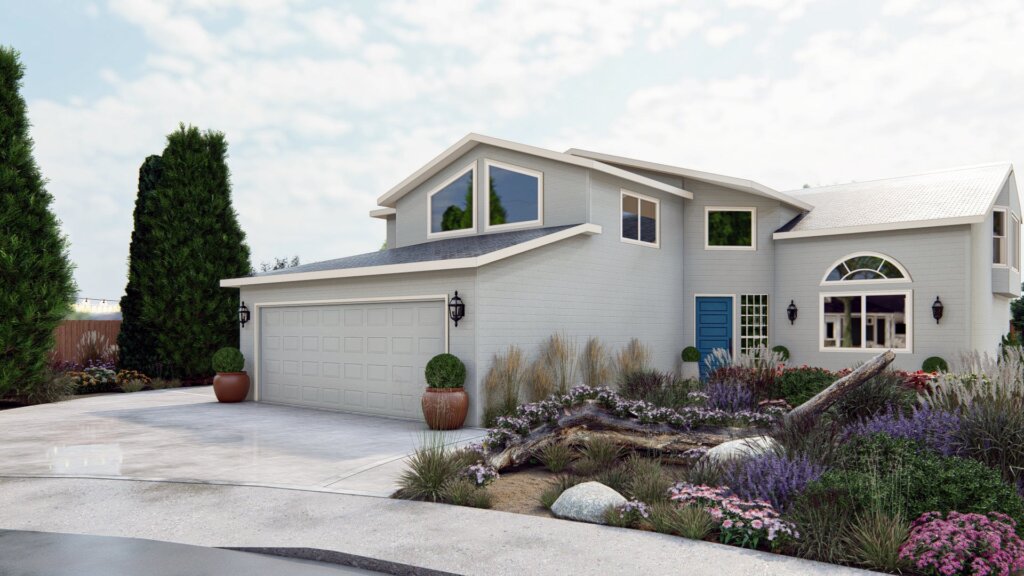
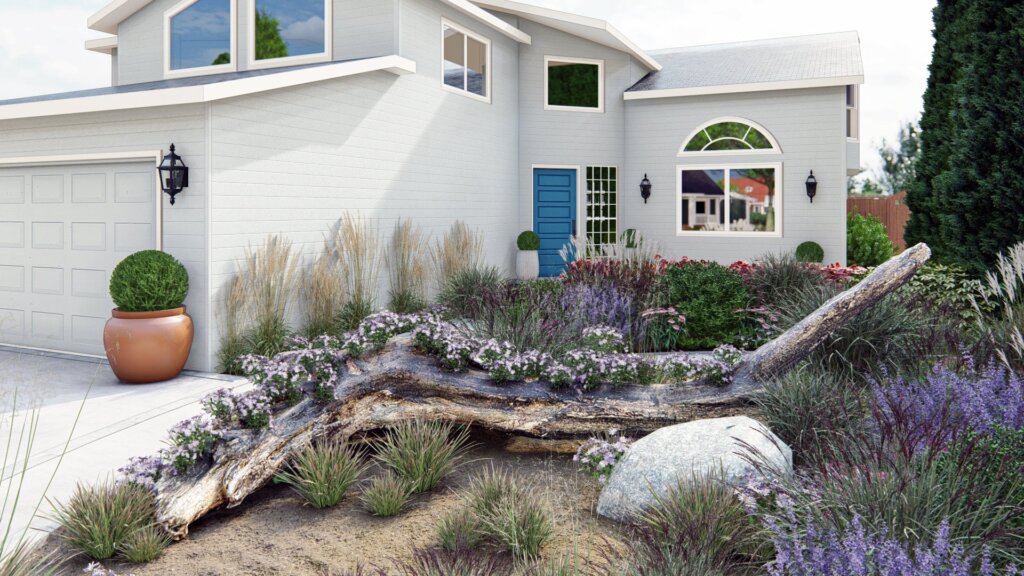
The front yard design for this Oregon home transforms formerly unused grass lawn into a textural, wildlife haven full of wispy ornamental grasses, pollinator-supporting blooms and structural evergreens for year-round visual interest. The addition of a fallen tree log overgrown with wildflowers is both a statement visual piece and habitat creator, providing important nesting and shelter for local fauna.
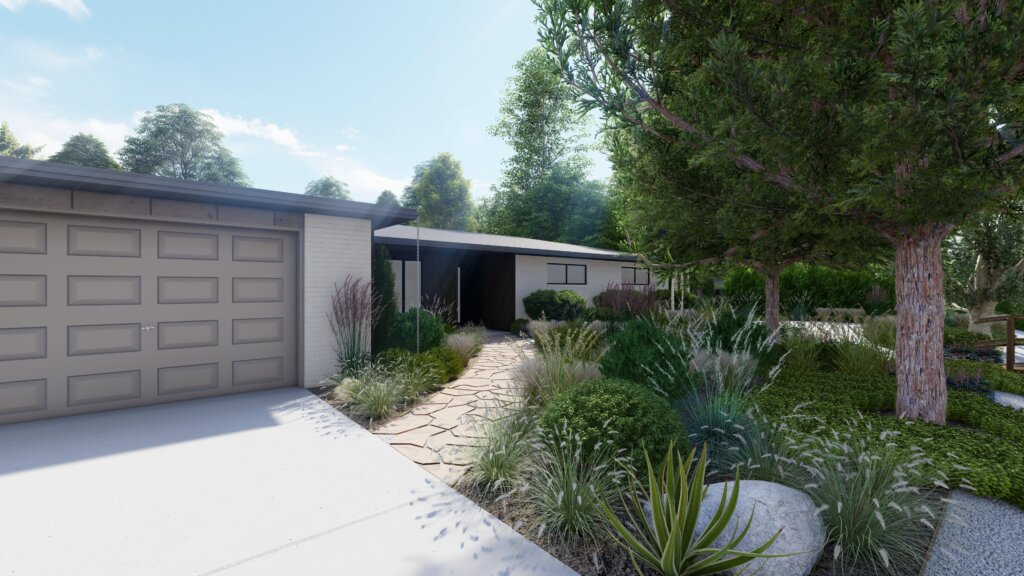
The homeowners of this Utah home wanted to remove all traces of grass in the front yard and replace with dense planting of low-maintenance and drought-resistant greenery in varied shades. The resulting design incorporates existing mature trees for ample shade and keeping ground temperatures cool. Native plants like Bouteloua gracilis ‘Blonde Ambition and Arctostaphylos uva-ursi ‘Massachusetts’ share space with evergreen shrubs for interest during the winter months.
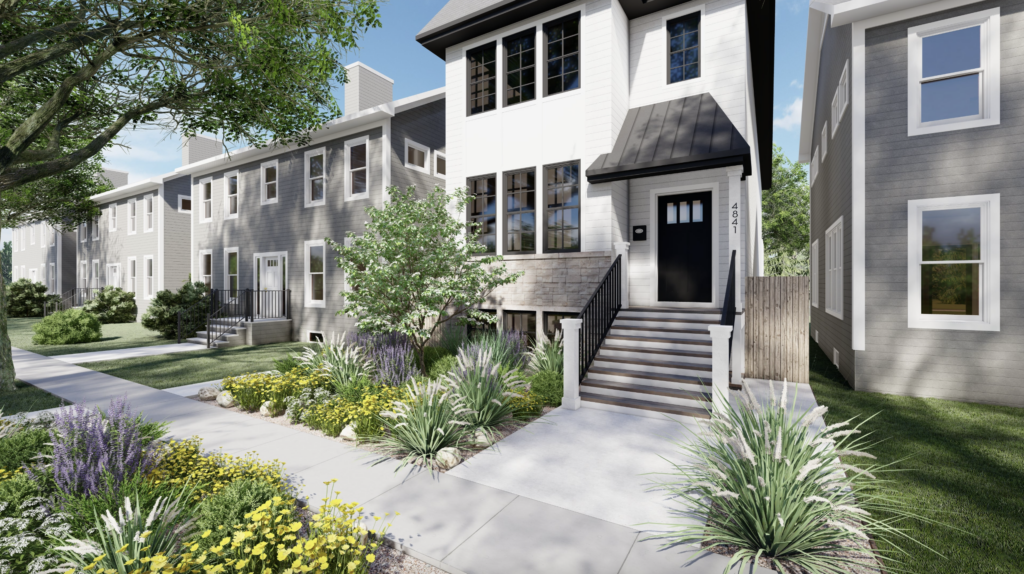
This urban Chicago front yard may be small, but it makes up for its compact size with a stunning array of yellow and purple blooms that immediately up the curb appeal. The client wanted to replace the standard grass lawn with a more wild and natural looking garden that incorporated native plants, abundant blooms and grasses. The design incorporates natives like Centered Achillea millefolium (white), Coreopsis grandiflora, and Panicum virgatum.
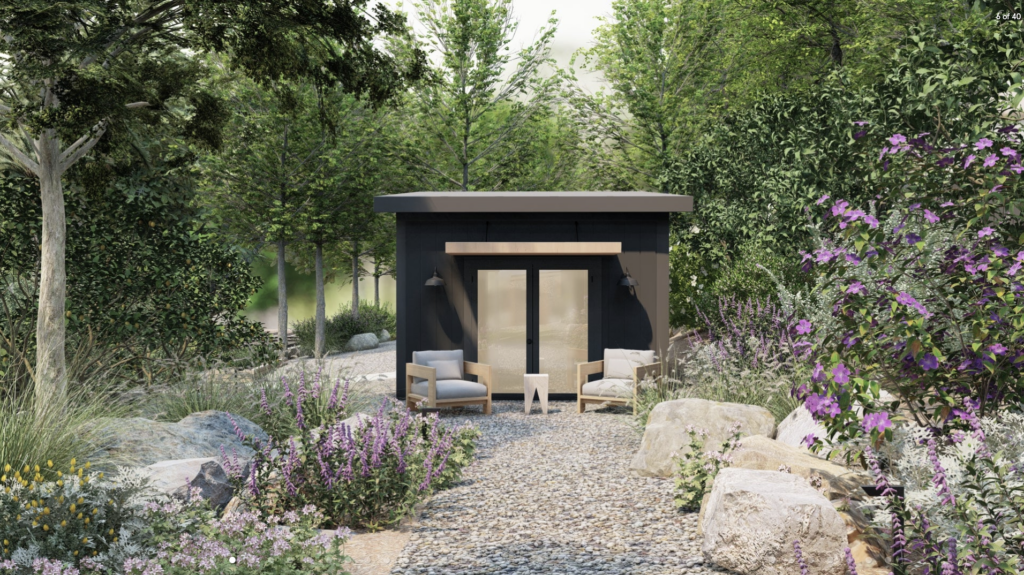
This California design is all about incorporating different textures, dimension and heights to create a yard where nature surrounds you in every nook and cranny. An organic and natural aesthetic — in planting, hardscaping and decor — brings a casual and lived-in vibe to this backyard. The falling leaves and acorns of California oaks can go unnoticed in this unfussy landscaping, providing shelter and food sources for local wildlife.

While not as dense as other typical rewilded yards, this design for a mountain vacation home in the Sierra Nevada offers low-maintence plantings that require little upkeep from afar and that can withstand both cold, wet winters and hot, dry summers. The botanical plan includes native plants like Carex praegracilis, Achillea millefolium ‘Terra Cotta’, and Carex praegracilis along with climate-adapted perennials and ornamental grasses.


This Colorado Front Range home features native plants like Aquilegia caerulea, Penstemon strictus, Penstemon palmeri, and Campanula rotundifolia. The homeowner requested a show-stopping front yard that would both have a wow-factor from the street and would also be in line with an HOA-defined list of acceptable plants.

This Oakland, CA sloped front yard features dense planting of drought-tolerant plants including climate-adapted perennials, ornamental grasses and low-water succulents. The upper level of the yard features a grass alternative groundcover, Dymondia margaretae.
Rewild Your Yard with Yardzen
You don’t need to have a degree in ecology to do a little good for the world with your yard. You also don’t need to be an expert at landscape design.
If you are interested in making your yard more sustainable, Yardzen can help. Our designers are pros at sustainable landscape design, and can expertly balance your style goals, functional needs, and sustainable aspirations into a high performing, beautiful design that is custom just for you.
Our award-winning online landscape design is tailored to clients in all fifty states in the US. Through the American Rewilding Project, we are committed to creating designs with climate-adapted plants and water saving landscaping in drought-prone regions unless homeowners specifically opt out.
Our design process begins with understanding your space, your aesthetic preferences, and a discussion of your budget and vision to minimize surprises when it comes time to build.
Once your design is complete, we’ll help you connect with a local contractor from our Pro Network of vetted professional landscapers to install your new design.Ready to level up the sustainability (and style) of your yard? Create your design profile or explore our design packages today!
Ready to design your dream yard?
Get StartedFeatured Articles
Easy Ways to Turn Your Yard into a Sustainable Landscape

Guide to Meadowscaping (and Gorgeous Landscaping Examples)
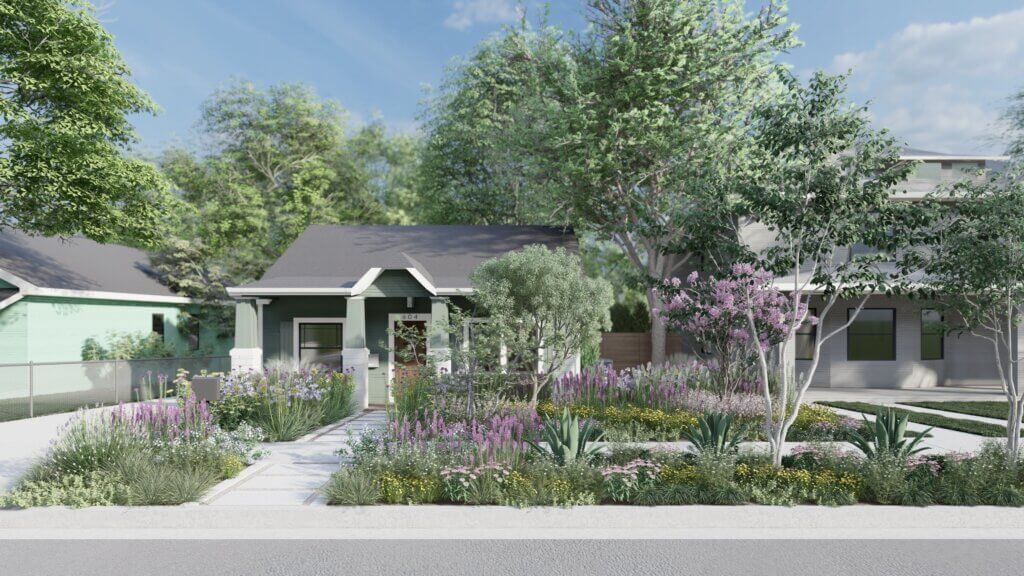
Our Favorite No-Grass Front Yard Ideas

Pollinator Garden Design for Beginners
